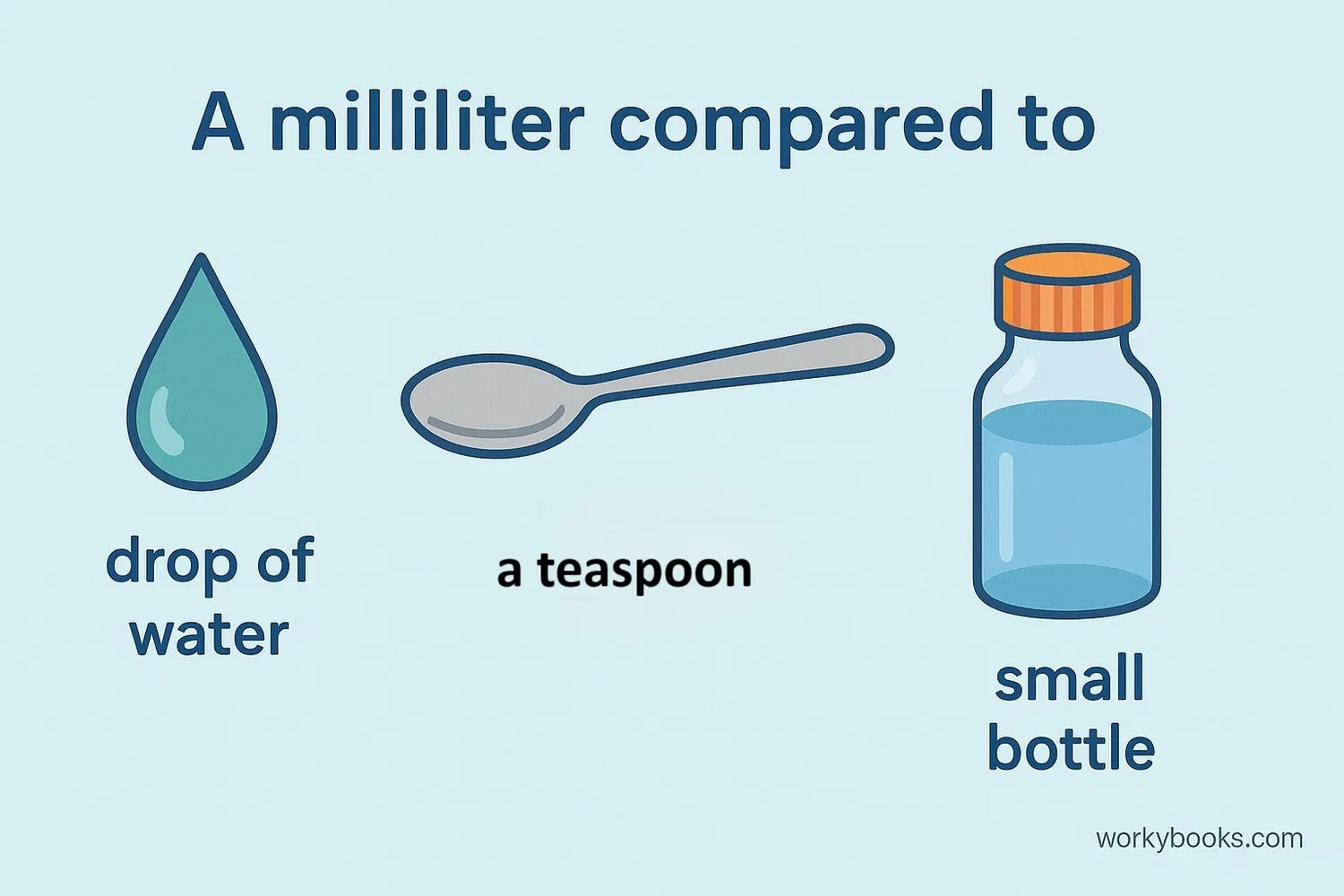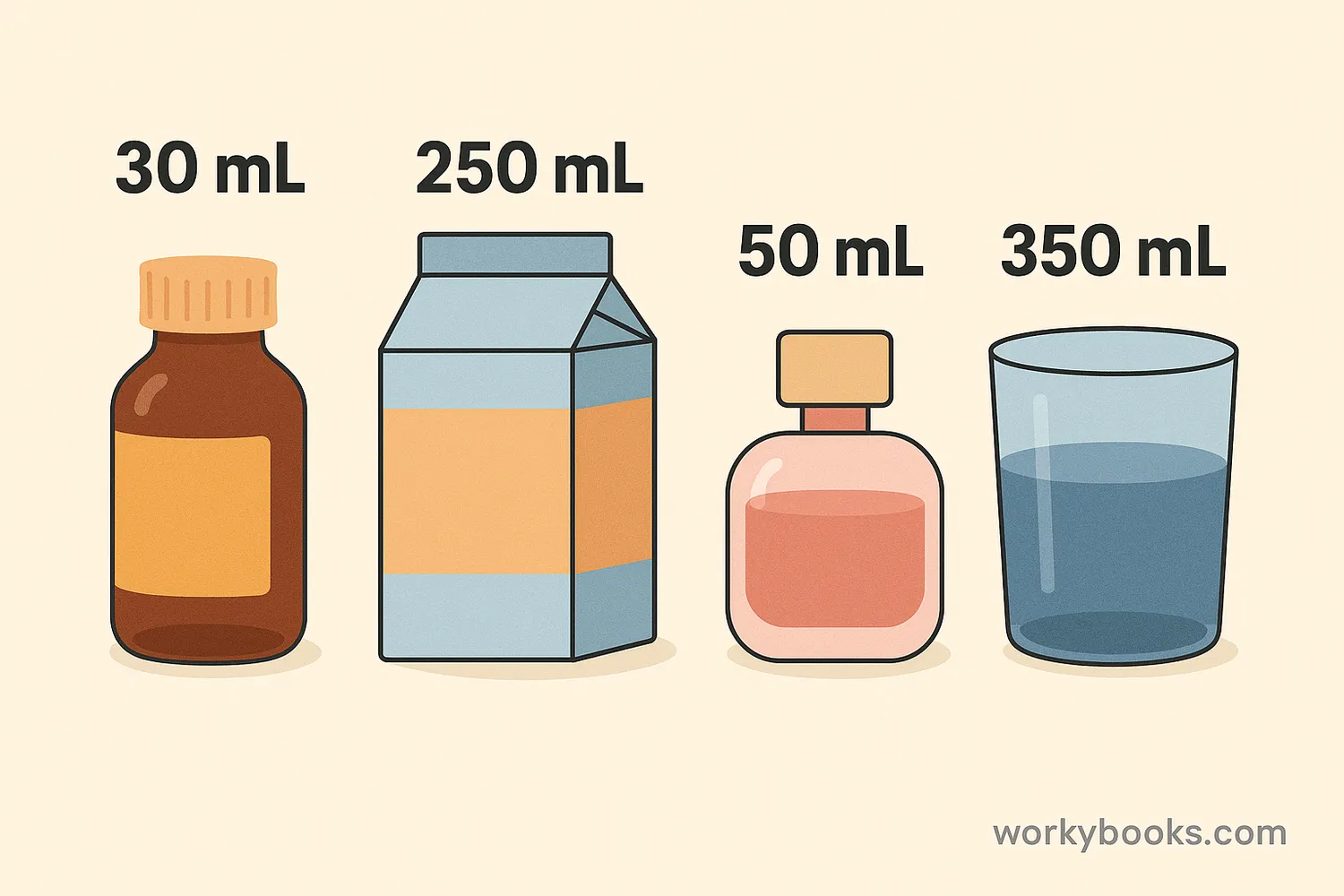Milliliter (mL) - Definition, Examples, Quiz, FAQ, Trivia
Learn about milliliters as a unit of volume measurement with examples and practice activities
What is a Milliliter?

A milliliter (abbreviated as mL) is a metric unit used to measure small amounts of liquid. It is equal to one-thousandth of a liter.
Think of a milliliter as:
- About 20 drops of water
- The amount of liquid that fits in a small medicine cup
- A little less than ¼ of a teaspoon
Milliliters help us measure liquids precisely. We use them in cooking, science experiments, medicine, and many other places where accurate measurement is important.
Key Concept
1 milliliter = 1/1000 of a liter. This small measurement helps us be precise with liquids.
Milliliters in the Metric System
The metric system is a decimal-based system of measurement used around the world. For volume measurement, the basic unit is the liter.
Milliliters are part of this system:
Metric Volume Units
The metric system uses prefixes like "milli-" to show fractions of the base unit.
- 1 milliliter = 1/1000 liter
- 1 liter = 1,000 milliliters
Other metric volume units include:
- Centiliter (cL) = 1/100 liter (10 mL)
- Deciliter (dL) = 1/10 liter (100 mL)
Remember
The metric system is based on multiples of 10, making conversions between units straightforward.
Converting Milliliters and Liters
Converting between milliliters and liters is simple because the metric system is based on multiples of 10.
Conversion Formulas
Example 1: Convert 2 liters to milliliters
Step 1: Start with the measurement in liters → 2 L
Step 2: Multiply by 1,000 → 2 × 1,000
Step 3: Calculate the result → 2,000 mL
Example 2: Convert 500 milliliters to liters
Step 1: Start with the measurement in milliliters → 500 mL
Step 2: Divide by 1,000 → 500 ÷ 1,000
Step 3: Calculate the result → 0.5 L
Milliliters to Liters Conversion Chart
| Milliliters (mL) | Liters (L) |
|---|---|
| 100 mL | 0.1 L |
| 250 mL | 0.25 L |
| 500 mL | 0.5 L |
| 750 mL | 0.75 L |
| 1,000 mL | 1 L |
| 1,500 mL | 1.5 L |
| 2,000 mL | 2 L |
Conversion Tip
When converting milliliters to liters, move the decimal point three places to the left. When converting liters to milliliters, move it three places to the right.
Real-World Examples

Milliliters are used to measure many everyday items. Here are some common examples:
Medicine
Liquid medicine is often measured in milliliters for accurate dosing.
Beverages
Small drink cartons and bottles often show volume in milliliters.
Cooking
Recipes use milliliters for precise liquid measurements.
Cosmetics
Products like shampoo and lotion are often sold in milliliter measurements.
Let's look at specific examples:
Example 1: A small juice box contains 250 mL of juice. How many liters is this?
Solution: 250 ÷ 1,000 = 0.25 L
Example 2: A water bottle holds 0.5 L of water. How many milliliters is this?
Solution: 0.5 × 1,000 = 500 mL
Example 3: A recipe calls for 300 mL of milk. You only have a 1-liter carton. How much will be left?
Solution: 1 L = 1,000 mL. 1,000 - 300 = 700 mL left
Look around your home for items measured in milliliters. You might find them in the kitchen, bathroom, or medicine cabinet!
Milliliter Measurement Quiz
Test your understanding of milliliters with this 5-question quiz. Choose the correct answer for each question.
Frequently Asked Questions
Here are answers to common questions about milliliters:
Measurement Trivia
Discover interesting facts about measurement and milliliters:
Origin of the Liter
The liter was originally defined in 1795 as one cubic decimeter. The milliliter naturally followed as one-thousandth of this measurement. The definition has been refined over time for greater precision.
Water's Special Property
At 4°C, one milliliter of water has a mass of exactly one gram. This convenient relationship between volume and mass makes water a reference point in the metric system.
Medical Precision
In medicine, doses are often measured in milliliters for accuracy. Even tiny variations can be important for medications, which is why doctors and pharmacists use precise milliliter measurements.
Tiny Drops
The size of a drop of water can vary, but typically 20 drops equal 1 milliliter. This means each drop is about 0.05 milliliters. Some specially calibrated droppers can deliver more consistent drop sizes.





